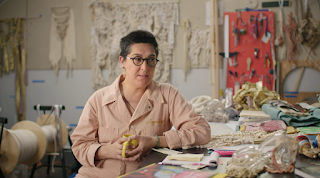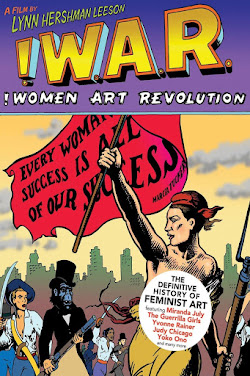Art21: "Borderlands" (S10, E3)
In this episode of Art21, the artists featured were Tanya Aguiniga, Richard Misrach, Postcommodity (Kade L. Twist and Cristobal Martinez), and Rafael Lozano-Hemmer. All these artists focused upon the "borderlands," or more specifically, the Mexico–United States border.
Tanya Aguiniga is an artist, designer, craftsperson born in San Diego, but raised in Tijuana. She states that “as a child, I was constantly being marked by my border identity. Not belonging to anybody, not belonging like the US or Mexico." As one who crossed the border as a child to go to school, her work focuses on her experience of her divided identity while also focusing on visibility and representation. Her aim was to have people and "their struggles mirrored." In a sense, she is a Border artist, using art to convey the divide and encourage discussion of the separation. She wants to convey the border as not "a place of pain or trauma" but a place that "we could reclaim." One work I found very fascinating of hers was her Metabolizing the Border from 2020. In this performance piece, she wears various pieces of glass (encompassing shards from the border) throughout her body to deal with the tragedies of the border "through the five senses." She then walked back and forth along the border, wearing the glass pieces on her face, ears, back, and feet. I was very enthralled by the sheer creativity she utilized of bringing a “physical-ness” to the trauma of border separation. Her idea for the performance was that "you can't escape the border," and it is not only present through the sheer stress and pressure the physical glass weighs upon her body but also the mental stress she is feeling, knowing she bears fragments of the border throughout her very skin.
Richard Misrach is a photographer, based in Emeryville CA. He likes to photograph activities to which nature and culture combine. He primarily works within the desert, which he believes to be his calling. While in the desert, he also discovered various things, like military bombing ranges, the nuclear test site, space shuttle landings, along with man-made fires and floods. His routine is to travel through the American desert and wander about, whilst getting inspired for new ideas or projects. For some of the things he discovers, like a barrel with a flag on top, he has no idea where they came from, but still photographs it. What he found out was that humanitarian groups left barrels full of water out for migrants crossing the border. This inspired him to create an entire series on capturing photographs of the various barrels from various state desserts near the border (his Border Cantos series, pictured below). He noted that he didn't intend to focus the political or societal context of his work, but in regards to what was happening at the time, he found a way to combine those elements into his photography. The way he interprets it “the desert was a vast stage where everything that happened there kind of projects onto the rest of America.” In other words, what he saw in the desert conveys the status of our society, a mixture of both beauty and ugliness.
Postcommodity is an indigenous art collective, founded by Kade L. Twist and Cristobal Martinez. It aims to convey an indigenous world view in relationship to the border. The collective creates site-specific works (ranging from installations to video or sound works), focusing on the indigenous history that was forgotten and disregarded in American culture, as a means of reinvigorating it. "Suturing is remembering, healing, and reasserting one's place on the land," both men state. One work that fascinated me was their Do You Remember When? from 2009. The installation involved a slab of concrete floor that was removed and mounted nearby on a pedestal. Thus, the spot where the concrete slab was missing showed dirt from the ground. Suspended above the dirt was a microphone, playing a faint audio of a speaker during a native Pee Posh ceremony. I was intrigued with this piece as it recalled back to the land and memories belonging to the indigenous peoples, and the context of their culture and history that was being wiped away and forgotten about.
Rafael Lozano-Hemmer is an architectural and performance artist, creating works that focus on technology in relation to the human connection. In his words “many of my works involve this process of taking a portrait of a participant, for example, like, of their face or their fingerprint or their heartbeat, and then making it into a landscape. Because it's beautiful to see your heartbeat, but it's more beautiful to see it in relationship to all these others. That's the kind of complexity that I'm interested in evoking." As such, he wants to incorporate the human body with technology, to help establish a connection we have to others (regardless of who we are). My favorite of his works was the Border Tuner from 2019. The purpose of it was to allow for the communication between two people, "establishing these new connections to create community." Interactive spotlights are installed that allow the viewer to move and change their direction, and speak through a microphone to have a conversation with another person that is by another spotlight in the distance. I found this interesting and endearing, as it was a clever way to have two people from far away establish a connection, without knowing who either person is or where they come from. Another profound installation was Voz Alta from 2008. The work is to commemorate the massacre of students in Tlatelolco Plaza. The installation had a megaphone set up to convert people's voices into light, to which searchlights would flash towards the Ministry of Foreign Affairs. I thought this was cool and fascinating, because that would mean anyone could use it, as the light would flash for any kind of dialogue (no matter what language you spoke). Thus, it brought people together collectively to convey to others to make a difference. The idea sounded abstract, but it upheld so much meaning and purpose. Overall, I found this piece thought provoking and clever.









Great choices. I agree that Rafael Lozano-Hemmer's "Border Tuner" is emotionally moving. It's also a political statement because people separated by the US-Mexico border between El Paso and Juárez could talk with each other.
ReplyDeleteI was planning on doing a blog on this video as well! I am fond of Rafael Lozano-Hemmer and saw this on Art21's website. I think it is a beautiful thing for them to reclaim this trauma into something more celebratory and acknowledging of the people divided by the border. I'm excited to watch this and learn about the other artist involved. Good job giving concise yet informative descriptions of the various artists and their contributions.
ReplyDelete